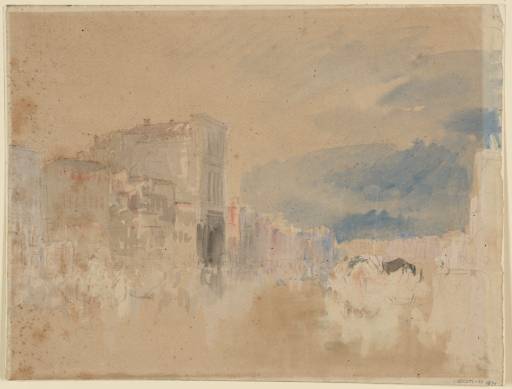Joseph Mallord William Turner The Grand Canal, Venice, with the Palazzo Grimani 1840
Joseph Mallord William Turner,
The Grand Canal, Venice, with the Palazzo Grimani
1840
Joseph Mallord William Turner 1775–1851
The Grand Canal, Venice, with the Palazzo Grimani 1840
D32169
Turner Bequest CCCXVI 32
Turner Bequest CCCXVI 32
Gouache, pencil and watercolour on pale buff wove paper, 234 x 305 mm
Blind-stamped with Turner Bequest monogram towards bottom left
Inscribed by John Ruskin in blue ink ‘1579’ bottom right
Stamped in black ‘CCCXVI – 32’ bottom right
Blind-stamped with Turner Bequest monogram towards bottom left
Inscribed by John Ruskin in blue ink ‘1579’ bottom right
Stamped in black ‘CCCXVI – 32’ bottom right
Accepted by the nation as part of the Turner Bequest 1856
Exhibition history
1904
National Gallery, London, various dates to at least 1904 (647, as ‘Venice. Grand Canal’).
1931
Display of Watercolours from the Turner Bequest, lent from the British Museum, National Gallery, Millbank (Tate Gallery), London 1931–March 1934 (no catalogue).
References
1904
E.T. Cook and Alexander Wedderburn eds., Library Edition: The Works of John Ruskin: Volume XIII: Turner: The Harbours of England; Catalogues and Notes, London 1904, p.638 no.647, as ‘Venice. Grand Canal’.
1909
A.J. Finberg, A Complete Inventory of the Drawings of the Turner Bequest, London 1909, vol.II, p.1020, CCCXVI 32, as ‘Grand Canal. Exhibited Drawings. No.647, N.G.’.
1930
A.J. Finberg, In Venice with Turner, London 1930, p.174, as ‘The Grand Canal’, 1835 or 1840.
1995
Ian Warrell, Through Switzerland with Turner: Ruskin’s First Selection from the Turner Bequest, exhibition catalogue, Tate Gallery, London 1995, p.108 under no.63.
2003
Ian Warrell in Warrell, David Laven, Jan Morris and others, Turner and Venice, exhibition catalogue, Tate Britain, London 2003, p.259.
The Turner scholar C.F. Bell annotated Finberg’s basic 1909 Inventory entry (‘Grand Canal’): ‘from the Rialto Cà Grimani on the left’.1 The view is to the east-south-east, with little differentiation between the various palace façades except for the looming bulk of the Palazzo Grimani on the left; in the foreground at the far right is the Palazzo Papadopoli, with cargo boats moored below. Although the tones and colours of the washes are disrupted by the darkening of the buff paper (see the technical notes below), the light appears to come from behind the viewer, suggesting a morning scene.
A similar San Silvestro viewpoint was adopted for a better-preserved variation on white paper in the contemporary Grand Canal and Giudecca sketchbook (Tate D32137; Turner Bequest CCCXV 21), where the Palazzo Grimani is conspicuous again (Tate D32123; Turner Bequest CCCXV 7), as it is elsewhere in the present subsection;2 compare particularly Tate D32211 (Turner Bequest CCCXVII 26), on similar paper, looking in the opposite direction.
Technical notes:
Loose pencil work underlies the rapidly applied washes. The paper has darkened considerably owing to prolonged early display, except where a mount protected the edges; this is particularly noticeable on the right, where a wider strip was covered and the blue of the sky retains its brightness. There is also scattered spotting.
This is one of a few 1840 Venice works Ian Warrell has noted as on ‘Pale buff wove paper, produced by an unknown maker, with the watermark: “J W”’:1 Tate D32148–D32149, D32169, D32211, D32219, D32247 (Turner Bequest CCCXVI 11, 12, 32, CCCXVII 26, 34, CCCXVIII 28); see also Venice from the Lagoon (Fitzwilliam Museum, Cambridge),2 and The Rialto, Venice and The Palazzo Balbi on the Grand Canal, Venice (National Gallery of Scotland, Edinburgh).3 Warrell has noted paper conservator Peter Bower’s suggestion ‘that this type of paper was a deliberate forgery of Whatman paper and was possibly produced in Austria’,4 and that the ‘inferior quality has resulted in visible changes to the paper, which is especially prone to fading’.5
How to cite
Matthew Imms, ‘The Grand Canal, Venice, with the Palazzo Grimani 1840 by Joseph Mallord William Turner’, catalogue entry, September 2018, in David Blayney Brown (ed.), J.M.W. Turner: Sketchbooks, Drawings and Watercolours, Tate Research Publication, December 2019, https://www

